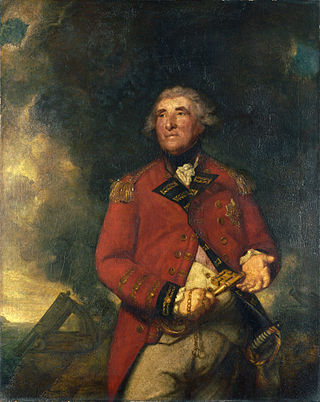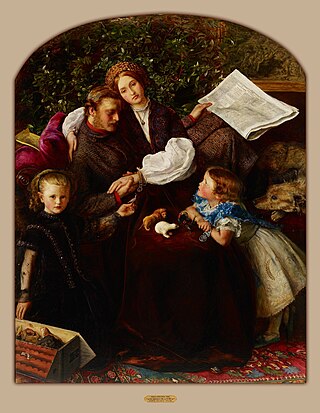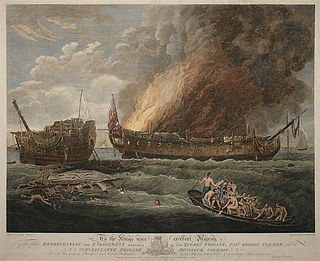
John Singleton Copley was an Anglo-American painter, active in both colonial America and England. He was probably born in Boston, Province of Massachusetts Bay, to Richard and Mary Singleton Copley, both Anglo-Irish. After becoming well-established as a portrait painter of the wealthy in colonial New England, he moved to London in 1774, never returning to America. In London, he met considerable success as a portraitist for the next two decades, and also painted a number of large history paintings, which were innovative in their readiness to depict modern subjects and modern dress. His later years were less successful, and he died heavily in debt. He was father of John Copley, 1st Baron Lyndhurst.

John Trumbull was an American artist of the early independence period, notable for his historical paintings of the American Revolutionary War, of which he was a veteran. He has been called the "Painter of the Revolution".

George Augustus Eliott, 1st Baron Heathfield, was a Scottish officer of the British Army, who served in three major wars during the 18th century. He rose to distinction during the Seven Years' War when he fought in Germany and participated in the British attacks on Belle Île (France) and Cuba. Eliott is most notable for his command of the Gibraltar garrison during the Great Siege of Gibraltar, which lasted from 1779 to 1783, during the American War of Independence. He was celebrated for his successful defence of the fortress and decisive defeat of Spanish and French attackers.

Elizabeth Castle is a castle and tourist attraction, on a tidal island within the parish of Saint Helier, Jersey. Construction was started in the 16th century when the power of the cannon meant that the existing stronghold at Mont Orgueil was insufficient to defend the Island and the port of St Helier was vulnerable to attack by ships armed with cannons.
The 83rd Regiment of Foot was a British infantry regiment that served in the American Revolutionary War. It was created in 1778 and disbanded in 1783, shortly after the war ended.

The Battle of Jersey took place on 6 January 1781 when French forces during the Anglo-French War (1778–1783) and the American Revolutionary War unsuccessfully invaded the British-ruled island of Jersey to remove the threat it posed to French and American shipping. Jersey provided a base for British privateers.

The Parish Church of St Helier is the parish church of the parish of Saint Helier, Jersey. It is a Church of England church, one of the twelve 'Ancient Parish Churches' of Jersey, and serves as the Island's civic church and Pro-Cathedral.
Events from the year 1789 in art.
Events from the year 1783 in art.

Peace Concluded, 1856 (1856) is a painting by John Everett Millais which depicts a wounded British officer reading The Times newspaper's report of the end of the Crimean War. It was exhibited at the Royal Academy in 1856 to mixed reviews, but was strongly endorsed by the critic John Ruskin who proclaimed that in the future it would be recognised as "among the world's best masterpieces". The central figure in the painting is a portrait of Millais's wife Effie Gray, who had previously been married to Ruskin. It is now in the Minneapolis Institute of Arts.

The Defeat of the Floating Batteries at Gibraltar is the title of a 1791 oil-on-canvas painting by Boston-born American artist John Singleton Copley. It depicts the defeat of the floating batteries at Gibraltar during the Great Siege of Gibraltar. The Governor of Gibraltar, General George Augustus Eliott, is on horseback pointing to the rescue of the defeated Spanish sailors by the British.

The Surrender of Lord Cornwallis is an oil painting by John Trumbull. The painting, which was completed in 1820, now hangs in the rotunda of the United States Capitol in Washington, D.C.

Major Moses Corbet (1728–1814) was a British Army officer who served as Lieutenant Governor of Jersey from 4 April 1771 to 6 January 1781.

Major Francis Peirson was a British Army officer who was serving on Jersey, in the Channel Islands off the coast of France. He was killed in the Battle of Jersey, one of the last battles to take place in the British Islands.

George Carter (1737–1794) was an English artist who described himself as a "historical portrait painter". He visited Italy in the company of John Singleton Copley, who had a significant influence on his work, and spent some time in India.

The Death of the Earl of Chatham is the title of a 1781 oil-on-canvas painting by Boston-born American artist John Singleton Copley. It depicts the collapse of William Pitt, 1st Earl of Chatham on 7 April 1778, during a debate in the House of Lords on the American War of Independence. Chatham is surrounded by peers of the realm, and the painting contains fifty-five portraits.

Philipe Charles Félix Macquart, Baron de Rullecourt was a French soldier who became a general of the Kingdom of France. In 1781, he was mortally wounded commanding the attempted invasion of Jersey at the Battle of Jersey.

Benjamin Smith (1754–1833) was a British engraver, printseller and publisher, active from 1786 to 1833. He was born c. 1754 in London. He worked mainly in dot or stipple engraving, producing portraits, illustrations, and allegorical and biblical subjects after prominent artists of the day.

The Death of General Montgomery in the Attack on Quebec, December 31, 1775 is an oil painting completed in 1786 by the American artist John Trumbull. It depicts American general Richard Montgomery at the Battle of Quebec during the invasion of Quebec. The painting is on view at the Yale University Art Gallery in New Haven, Connecticut. It is the second in Trumbull's series of national historical paintings on the American Revolutionary War, the first being The Death of General Warren at the Battle of Bunker's Hill, June 17, 1775.

A Boy with a Flying Squirrel (Henry Pelham), or Henry Pelham (Boy with a Squirrel), is a 1765 painting by the American-born painter John Singleton Copley. It depicts Copley's teenaged half-brother Henry Pelham with a pet flying squirrel, a creature commonly found in colonial American portraits as a symbol of the sitter's refinement. Painted while Copley was a Boston-based portraitist aspiring to be recognized by his European contemporaries, the work was brought to London for a 1766 exhibition. There, it was met with overall praise from artists like Joshua Reynolds, who nonetheless criticized Copley's minuteness. Later historians and critics assessed the painting as a pivotal work in both Copley's career and the history of American art. The work was featured in exhibitions at the Museum of Fine Arts, Boston, and the National Gallery of Art. As of 2023, it is held by the former.



















